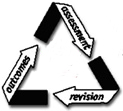Assessment Brief #92 - Professional Writing Assessment Activity
October 2016
In its 2015 report, the review team of the Higher Learning Commission noted that "While [assessment] plans are in place, full implementation of those plans is uneven across the University."To enhance the quality of Miami's assessment plans, the University Assessment Council is featuring exemplary assessment plans from diverse academic divisions in several Assessment Briefs. This Brief features the assessment activity for the A.B. Professional Writing program. The Higher Learning Commission looks for "full cycle" assessment of degree programs. This means that a program has clear and meaningful learning outcomes, multiple measures of assessment, data collection & analysis, sharing of findings, and development and tracking of plans for improvement that relate to the findings.
Learning Outcomes & Method
The learning outcomes for this major focus on elements of writing (e.g., statement of main argument, organization, support, style, and grammar/mechanics) in two genres: a rhetorical analysis essay and a public argument. In 2015-2016, artifacts of these two assignments from thirty students majoring in this program were collected in two 400-level core courses. Artifacts were assessed via two rubrics (each focused on a different genre with four gradations of quality for each writing element).Gradations of quality descriptions were concrete and specific rather than general. For example, instead of a vague description such as "exemplary organization," the description for the highest level for support reads: "Argument is supported with detailed evidence appropriate for purpose, audience, context and technologies of delivery; rhetorical appeals are nuanced and sophisticated." Student artifacts were collected and scored by two faculty members who have been trained in using the rubrics and who are not instructors of either course for that year.
Findings & Strategies for Improvement
Based on these findings, the faculty identified several recommendations for improvement of teaching and learning: (1) incorporate the opportunity for students with exceptional rhetorical analyses to work with faculty to revise their papers
In completing the rhetorical analysis essays, students demonstrated excellent depth of analysis and scholarly sophistication, including rigorous and detailed discussions of methodology. The essays, however, were not as strong in terms of close textual analysis and style. Similarly, the public argument projects were persuasive yet suffered from uneven written style and visual design.
Based on these findings, the faculty identified several recommendations for improvement of teaching and learning: (1) incorporate the opportunity for students with exceptional rhetorical analyses to work with faculty to revise their papers over the following term to submit for possible publication; (2) increase the time in class as well as the amount of feedback on improving sentence-level style in a variety of genres, including rhetorical analysis essays and public communication genres such as brochures and web sites.
Conclusion
The strengths of the assessment plan for this degree program include: (1) meaningful outcomes; (2) effective rubrics with concrete quality descriptions; (3) scoring of student artifacts by outside and trained faculty member; and (4) sharing and discussion of findings among all program faculty. The assessment activity could be enhanced by incorporating an indirect assessment measure of the outcomes (e.g., course evaluation data, surveys, focus groups). In addition, it will be important in future reports to explain which strategies were implemented and to track their effectiveness over time.


